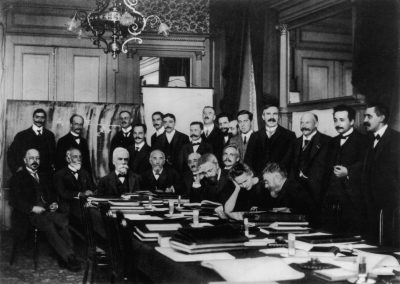
Great Founder Theory
This is an excerpt from the draft of my upcoming book on great founder theory. Learn more here.
A theory of history
Where are we, how did we get here, and where are we going? If we knew, could we change course? And what would it take to succeed? Many disciplines have sought to answer these proverbial big questions, with answers ranging from the philosophical to the biological and everything in between. But often overlooked is the value of history. The recorded history of human civilization over the last 10,000 years, with the stories and sagas of empires, religions, and great individuals have left us with a tremendous corpus of raw material to read and analyze. Should we?
Perhaps history is overlooked because it feels superficially irrelevant to contemporary problems and issues. Much of it may be. Alternately, we might take the view of the ancient Biblical book of Ecclesiastes that there is “nothing new under the sun”. Already, we must make an important epistemological decision. Our beliefs concerning large-scale patterns of the present world carry predictions for the future and explanations of the past. Yet, when we think about society as a greater whole and the humans in it, it seems all too natural to consider these kinds of models separately.
We change explanations of social phenomena to fit time periods, without principled reasons for doing so, for why some factors come to dominate. This divide is an artifact of our lived experience and limited knowledge, not of reality itself. Whether we like it or not, attempting to evaluate reality on the scale of society is to implicitly claim an overall theory of history.
In order to create such a theory, it is necessary to explore the functioning of institutions, the transmission of knowledge, and the landscape of power, among a number of other key dynamics. These phenomena substantially overlap and interact. I will summarize and illuminate this overlap, and try to make the common driving factor of their dynamics explicit in what I call “Great Founder Theory.”
On institutions
What is an institution? This term conjures associations with organizations such as governments, courts, corporations, and universities. For our purposes, an institution is a zone of close coordination maintained by automated systems.
There is a spectrum of automation, however, and the more automated something becomes, the more useful it is to call it an institution. The most automated of institutions can be understood as bureaucracies.
We can understand the world as a landscape of functional and non-functional institutions. Functional institutions are the exception. Creating functional institutions requires a founder who knows how to coordinate people to achieve the institution’s purpose, and who uses this knowledge to build new institutions or dismantle and rebuild existing ones.
Non-functional institutions are not simply institutions where, say, the buildings are on fire or mass layoffs have started. We might call those failed institutions, at the extreme end of non-functionality. Rather, the vast majority of non-functional institutions merely inadequately imitate functional institutions. In the institutional landscape, those are the norm, rather than the exception. They attempt to copy the relevant social technology from one or several functional institutions. Such non-functional institutions can still easily generate narratives of being goal-oriented and functional, both for internal consumption by functionaries and external consumption by observers and competitors.
The internal narrative helps non-functional institutions achieve modest effects locally, but these are side effects of socializing. Its members might individually pursue actions towards the organization’s goal, perhaps even believing they are pursuing them effectively; however, the social interface rewards appearance rather than reality, hence close cooperation towards the organization’s goals cannot materialize. The narrative is not only maintained internally, but broadcast to external society as well in order to invite participation in the appearance of functionality. Everybody has to keep their story straight.
One sign and symptom of this simple optimization for appearance is that everyone in the organization is trying to perform the same kind of task—the one that is most socially rewarded—rather than them being specialized according to their function.
The body of the institution becomes a social club gathered under pretense. We shouldn’t disparage the value of socializing itself. Anomie, the rift between individual and community, has only grown since the sociologist Emile Durkheim introduced the concept in his diagnosis of 19th century society. Given our predicament, it is perhaps wise to try and build community by any means available, so our society should tolerate some false pretense for socializing. Perhaps that is the very reason we have even more non-functional institutions today than the historical average.
However, whatever the talent or intentions of individuals within such a non-functional institution, the main body of the institution, the communal fabric of socializing and even material incentive, stands in the way of fully realizing the institution’s nominal function.
Ultimately, vital functions must be realized. To name only a few, imagine militaries that cannot win wars, churches that cannot maintain communities, governments that cannot guarantee security, universities that cannot maintain intellectual life, courts that don’t uphold the rule of law, and industries that fail to advance technology.
To fail at all of these functions would amount to a failed society.
Limits to knowledge and effects of imitation
A society can make do with having some functional institutions and some dysfunctional institutions. You could argue that the Roman Empire for century after century succeeded in building armies that could win wars, but failed to maintain the intellectual life inherited from the Hellenic era, for example.
Even then, such a society pays a high and often invisible opportunity cost. They might believe their institutions are functional, because they have simply never seen the functions carried out well. There are no outliers that can be used to disprove the thesis that the status quo is the best that can be done.
The invisibility of dysfunction may follow from a lack of viable comparisons. Comparisons between often competing societies are difficult, because of clashing politics and social narratives. How well would a French audience have received a treatment of the strategic merits of pan-Germanism in the aftermath of the Franco-Prussian War? Comparisons across time are difficult, because of confounding factors we cannot control for. Commentators and historians today draw all kinds of parallels between contemporary America and historical empires, yet there is no single comparison that seems notably more explanatory than the others. Comparisons against theoretical ideals are limited by the quality of theory. We might only be able to clearly compare functional and non-functional institutions when functional institutions still exist in a domain of society. This illustrates what a crucial difference even one functional institution can make.
A functional institution is only an instance of a class. There is more than one technology company, for example, though there might be only one truly innovative company per industry.
If an organization is clearly better, it is possible to imitate it. In a famous Caltech commencement address, Feynman explained the folly of simple-minded imitation, likening such imitation to the notion of the “cargo cult”: just as a lucky hunter-gatherer tribe that was in the path of cargo airdrops during World War II built imitation airstrips and wooden control towers after the war under the expectation that such forms were the causes of cargo airdrops, so too do we copy the appearances of old functional institutions without understanding or replicating their true nature. As long as the functional example is still around, however, you can keep returning to it, each time narrowing in on what steps actually make it work. You are only stuck building wooden airplanes or wearing turtlenecks if the original is no longer around. Success through reverse engineering is much easier than blind trial and error, even after controlling for false starts and dead ends.
This kind of imitation can bring you to an increasingly better approximation of a given set of social technology. However, since the social technology behind functional institutions wasn’t discovered through blind tinkering, it is ultimately grounded in an existing tradition of knowledge.
Once that tradition is lost, you are making photocopies of photocopies. Each subsequent copy loses information. A crucial difference between organisms and organizations is that organizations do not undergo natural selection. Since the fidelity of transmitting intricate social technologies is so low, complex adaptations cannot arise.
There is no corporate equivalent to DNA. The positive copying errors do not propagate and overwhelm the negative copying errors as they would in millions of years of evolution in wasps or elephants. This means that institutions only arise through the process of imitation and invention carried out by human minds.
A single new functional institution that visibly and strongly outperforms others in its reference class offers an educational example that can be followed by many. Imitation of practice is much easier and faster than transfer of knowledge, especially when the tradition of knowledge is still alive to be imitated.
Some functional institutions shoulder the burden of their civilizational function entirely on their own. There was only one organization that went to the Moon: NASA under Wernher von Braun.
Whether because of the scale of the task they handled and consequently their solitary nature, or because other institutions learn from their crucial example, functional institutions are often irreplaceable. When a functional institution dies, the living tradition of knowledge disappears, succeeded only with ever fainter echoes.
Such institutions, when they arise, provide far more value to society than they can possibly capture for themselves or their founders.
A civilization is an ecosystem of institutions
In “Institutional Failure as Surprise,” we explored how institutions rely on each other for handling many necessities. Examples include infrastructure, enforcement of contracts, security, intellectual culture, design… too many to exhaustively name.
No single institution is self-sufficient. Rather it is a part of an ecosystem, receiving and giving support in complex arrangements. Due to interdependency and the extreme differences in functionality among institutions, functional institutions subsidize all others. Consider, for example, how companies like Apple or Facebook, which provide hardware or software platforms of unprecedented scale, make it possible for ecosystems of apps and games — and the companies that develop them — to thrive. Facebook could survive without Zynga, but not vice versa.
Functional institutions solve and handle hard tasks not just for themselves but many other organizations and communities. Thus, even mere social groups, being able to outsource from (not to mention imitate) functional institutions, can become quite productive.
The reason is that there are multipliers external to the social group, provided by functional institutions elsewhere, that make the nonfunctional institutions’ modest linear efforts worthwhile.
In a civilization with several functional institutions, everything seems to work very well. The ubiquitous perception of functionality is then reflected in the culture and produces a very palpable mood of optimism. Nothing seems beyond the civilization’s grasp.
People impact the world through institutions they build
The term institution is similar, but not synonymous, with the concept of an empire, though they can overlap in some cases. An empire is a region of coordination around a central power, where the central power is the cause of the region of coordination. An institution can be the entirety of a given person’s empire, but such an empire can also include multiple institutions. Naturally, functional institutions can extend the reach of personal empires.
I argue in “Competition for Power” that people’s impact on the world follows a Pareto-like distribution, with the most impactful people having a far greater impact than the rest. The creation of functional institutions is the means by which people are hugely impactful. People who build institutions are far more impactful than people who don’t, and among those, people who build functional institutions are by far the most impactful.
The height of personal power amassed by creators of functional institutions can certainly dwarf that held by those merely inheriting them. But power is a means, not an end. The big picture impact of such impressive personal empires doesn’t lie in the power to right particular wrongs or achieve particular aims, but rather in how such empires lay the foundation for building further institutions.
A functional institution can outright solve a problem for a civilization. It might, for example, complete the construction of infrastructure so important it changes the course of economic development for centuries to come, such as ancient China’s grand canal or a hypothetical space elevator.
A functional institution can subsidize the working of many other ventures through providing services that other institutions and communities can rely on. One might consider Hammurabi or Muhammad’s systems of law as examples, with many other revered lawgivers in history besides.
Those who build these functional institutions mold society. Among the founders of functional institutions, those who build the most functional institutions are much more impactful than the rest.
As a further consequence, the founders of these institutions are responsible for the vast majority of social technology that we see in society. Most social technologies, especially advanced ones, cannot be explained by evolutionary analogy, whether Darwinian or Lamarckian, although mutation and evolution may be helpful in explaining the ways in which social technology decays.
Rather, social technologies appear in clear, discontinuous jumps, with several interlocking, interdependent institutional complexes put into place in a short time span. They did not evolve, but were designed and then implemented. The Founding Fathers of the United States, who created Congress, the Presidency, the Supreme Court, and much more, all at once, serve as a clear example.
I will call those who found the most functional institutions that contribute to the bedrock of their civilizations Great Founders. Through the creation of institutions, Great Founders become the primary force that shapes society.
To examine a society, then, we should first look for functioning institutions. A simple way to do this is to identify businesses, religions, governments, and so forth that are radically outperforming their competitors. We then seek out the founders of these institutions.
By looking at the distribution of founders across various domains, we can make predictions about the future of specific fields and industries. Even further, by investigating the plans and intentions of Great Founders, and evaluating how likely they are to succeed, we can make specific predictions about what the future holds.
The actions and capabilities of Great Founders determine the future social and material landscape of civilization, and thus the future of the world. Societies with many Great Founders will innovate and flourish, while societies with few will stagnate and deteriorate.





